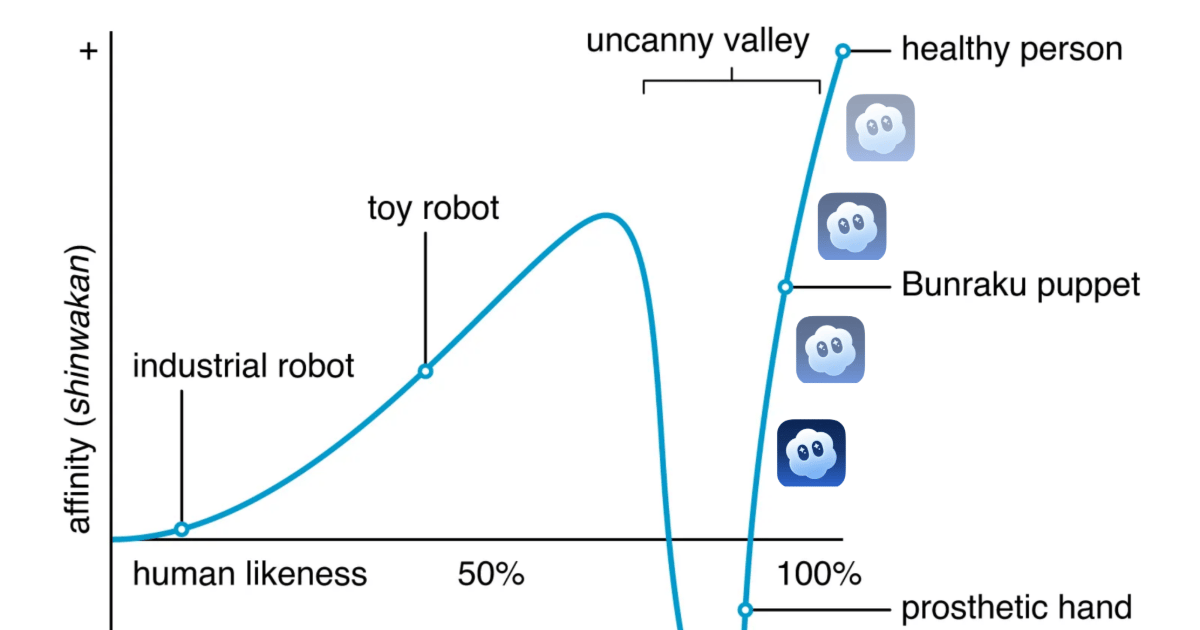Ever since Stable Diffusion and Dall-E 2 launched in 2022, marketing leaders have tried to make AI ads work. But with the exception of a few viral hits with short-term novelty value, this has been almost entirely in vain.
Then, on October 1st, 2025, Sora 2 launched, and everything changed.
AI advertisements have had their own ChatGPT moment.
Advertising’s uncanny valley
The concept of the uncanny valley was first introduced in 1970 by Japanese robotocist Masahiro Mori. He proposed a beautifully counter-intuitive theory that as basic robots became increasingly humanlike, they would tend to generate more affinity from humans, up until the point where they were nearly-human looking, at which point they generated less human affinity.
This period in which humans are close enough to be almost-recognizable as humans, but still very clearly not human, is the uncanny valley.

This effect has proven particularly prescient in marketing: people will of course regularly buy products recommended by real human creators, but they will also often buy from ads starring cartoonish characters, stick figures, and even animals, as the Charmin bear will attest, with a comforting smile:

But what about human-esque AI avatars? Or AI creators? Despite much commentary and excitement, they have never really converted to sales. They have always been creepy. When I wrote my last post about AI avatars in social media in June 2024, we were still very much in the uncanny valley.
This is exactly as Masahiro Mori predicted all those years ago: the closer to humanlike they were, the worse they would perform. We have seen this from our portfolio: attempts to use AI ads were generally met by comments like “nice try diddy” or worse, accusations of cringe.
These last two weeks, everything has changed. There is no doubt about it: Sora’s videos can garner affinity, and crucially, drive sales.
What makes Sora 2 special
The magic of Sora 2 is not just the hyper-realistic avatars. Google’s Veo 3 had already mostly solved that; the human appearances were already near-indistinguishable from reality.
But much like all of OpenAI’s launches before it, a significant chunk of the breakthrough was in the details that were clearly obsessed over: sound design, speech tone, audio effects and timbre, eye contact, character consistency, cameos, instruction-following, and generated dialogue.
Sora videos can make you laugh (perhaps disturbingly). And there is no doubt that once a video can make you laugh - it can impulse-sell you a meditation app you’ll use twice.
And it will only be a matter of time until it can make you cry.
Sora 2 has become realistic enough that we are now climbing out of the uncanny valley.
Ads on Sora, forever
Consumer internet founders immediately took notice of Sora’s capabilities. Several of our portfolio companies began exploiting it from the first week. The formula is something like this:
Take over dozens of real UGC accounts on TikTok from creators (they can be acquired or taken over very inexpensively)
Make hundreds of varieties of Sora clips based on your (or your competitors’) best historical winning creatives. These can be only tangentially related to your product, but they must be eye-catching, funny, or viral. This can be done in the Sora app or for longer and more complex clips, a self-service platform such as our self-service AI ads portfolio company Creatify (which has had its fastest-ever growth this month)
Gradually post each of these creatives across the different accounts
Use other real UGC accounts that you have taken over to comment information about your startup, and like these comments from the UGC accounts so it becomes the top comment
Repeat
This works for now. Likely it will soon get saturated, until the next AI ads hack is born. Perhaps eventually AI will be heavily watermarked or separated from traditional social platforms as I predicted in January 2023. This will not be a straight line. But we have reached the tipping point, and the direction from here is clear.
A new era
Just like ChatGPT’s launch in November 2022, the impact of Sora will take months or possibly years to be understood by WPP, Publicis and Omnicom, and by extension their enterprise clients.
Legacy brands will no doubt consider Sora ads cheap, risky and demeaning. Board members, venture capitalists, and in some cases, CEOs, will recommend it, but midlevel marketing managers with existing creative workflows will doubtless resist. “It doesn’t fit our brand guidelines”, “The content is low-end”, “Our users say they don’t like AI”.
For startups, none of this matters. A startup’s brand is determined by their product, not their marketing. Startup ads can be irreverent. Startups don’t have existing AI-hating users to worry about.
This gives startups a big advantage over corporates; the risk arbitrage is on their side. What is unclear is how long this will last; social media is in constant evolution.
The only advice without a short-term expiry date for founders is this: assume video AI ads will keep getting better, lean into them, and hire marketing people who have a bias to do the same.
Because however long it takes to filter through the marketing ecosystem, one thing is for sure: generative video has broken through the uncanny valley, and AI marketing videos are here to stay, forever.
The last recorded interview with Masahiro Mori was in 2012, at 85 years old, where he stated that “we have not yet crossed the valley”.
In a cruel twist of fate, Mori died nine months ago in January 2025, at 97 years old.
So the uncanny valley’s inventor never got to see us escape it.
Fortunately, billions of others will.


